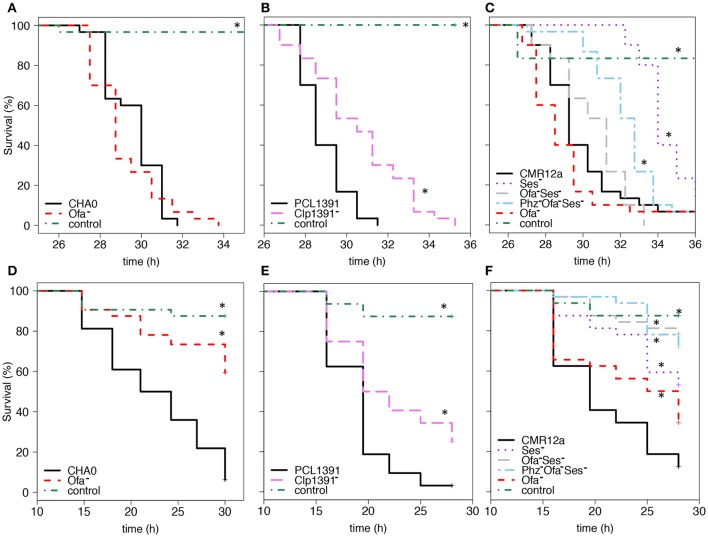Figure 2.
Cyclic lipopeptides contribute to insecticidal activity of three plant-beneficial pseudomonads. (A,B,C) Injectable activity against Galleria mellonella. 30 larvae per treatment were injected with 2 × 103 bacterial cells and survival was recorded hourly. (D,E,F) Oral activity against Plutella xylostella. For Pseudomonas protegens CHA0 (D) 64 larvae were exposed to artificial diet inoculated with 4 × 106 bacterial cells. In experiments with strains Pseudomonas chlororaphis PCL1391 (E) and Pseudomonas sp. CMR12a (F) 32 larvae were exposed to diet inoculated with 2 × 107 bacterial cells. Sterile 0.9% NaCl solution served as control. Treatments that differed significantly from their respective wild-type strain (Log-Rank test p ≤ 0.05, Survival Package in R) are marked with an asterisk. This figure shows the survival curves of one representative experiment per strain and insect system. The LT50 values corresponding to these experiments and to a repetition of them are depicted in Tables 2, 3. Solid black line, wild-type strain; dashed red line, mutants deficient for orfamide production (Ofa−, CHA5101, CMR12a-ΔClp2), dashed pink line, mutant deficient for Clp1391 production (Clp1391−, PCL1832), dotted purple line, mutant deficient for sessilin production (Ses−, CMR12a-Clp1); dashed gray line, double mutant deficient for sessilin and orfamide production (Ses−Ofa−, CMR12a-ΔClp2-Clp1); dash-dot light blue line, triple mutant deficient for sessilin, orfamide and phenazine production (Ses−Ofa−Phz−, CMR12a-ΔPhz-ΔClp2-Clp1); dash-dot green line, 0.9% NaCl solution control.

